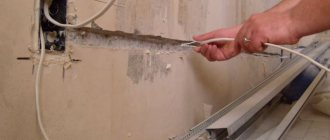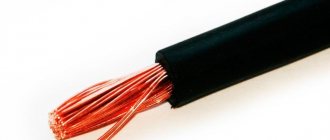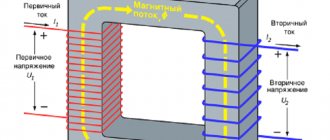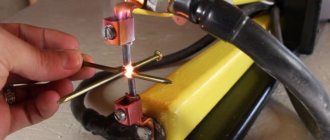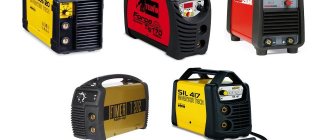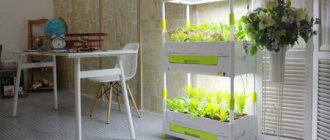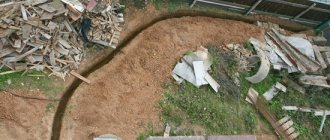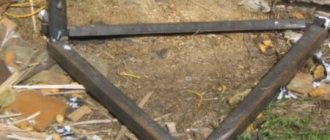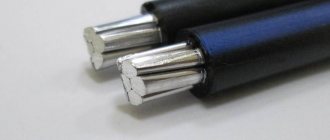Welding is an excellent way to connect parts; it occurs by melting metals using a welding arc. This type of connection is called arc welding. But to carry out the work you need to know a number of subtleties - polarity, choice of current, electrodes and, finally, the cable itself. The latter is needed to connect the welding inverter to the power source, as well as connect the ground clamp and electrode holder directly to the welder itself. In this article we will look at how to choose a cable for a welding machine, what should be the cross-section and grade of the conductor.
Cable requirements for a welder
Firstly, if you choose a cable to connect the ground clamp and electrode holder to the welding machine, you need to consider the following operating features:
- Welding machines of any type produce significant currents - from 10-20 to 400-500A. At the same time, household inverter-type welding machines are usually designed for 200A with a deviation of 50A in each direction, and industrial welding transformers produce currents of 400A.
- A welder encounters a wide variety of tasks in his work, from simple seams in convenient positions to welding products of complex shapes or in hard-to-reach places.
- In addition to various tasks, you have to cook both in very hot rooms and in the cold in winter.
- To transport the equipment, the cables are rolled up.
It follows that the cable must meet the following requirements:
- The power welding cable must be flexible to ensure ease of manipulation of the electrode or torch for a semi-automatic welding machine.
- The conductor must have thick insulation and be resistant to aggressive environments, shocks and breaks.
- To work in cold conditions, the conductor must be frost-resistant.
- Welding of metals occurs with low voltage but high current, so there is a separate requirement for the cross-section of wires for connecting electrode holders and ground. This means that the wire must be thick to minimize voltage sags and losses.
- Must withstand repeated bending and winding/unwinding during transportation.
The best cable option for winter work
COG1. “The cable is especially flexible, class 1 flexibility.” The cores inside the cable are thinner than other cords, which ensures high flexibility of the entire wire.
- This property is great for working in places where it is difficult for the welder to get close to the welding area or when working at heights where the cable has to be wrapped around the hand (for ease of work).
- The disadvantage can be considered the highest voltage skip of 220V with a frequency of no more than 50 Hz.
CPEC
"Hollow electric welding cable." Instead of wires, a spiral-shaped tube is used through which the wire is passed. The cable is designed for welding in semi-automatic mode.
- Due to the design features, the service life of this type of wiring is shorter than that of other cables - an average year.
- Passes through itself a voltage of 42/48V for any type of current.
- The cost of the cable depends directly on its cross-sectional size.
PIC
The abbreviation refers to the use of polyvinyl chloride plastic. This insulation provides increased wear resistance of the cable, significantly increasing abrasion resistance.
KVS cables are suitable for use in various conditions:
- In hot and humid environments with temperatures up to +40 degrees Celsius and in frost conditions down to -40 degrees.
Unfortunately, PVC cannot boast of its flexibility, for this reason it is often used for connecting to the network.
Suitable cable brands and types
The most popular option for a welding machine is the KG cable; it is a flexible single-core cable with a stranded core in rubber insulation. COG is also popular - with increased flexibility. There is also a specialized KS, these are the main brands of conductors that are used for welding work.
The title may also contain a note about the performance:
- T – tropical version, can operate at ambient temperatures up to +50 (according to some sources 85) degrees Celsius.
- KX or HL - frost-resistant, works even at -60 degrees Celsius.
And also the prefix P - an additional sheath of the core made of polymer materials.
The numbers in the marking indicate the number of cores and their cross-section, for example: KG 1x16 indicates that it consists of 1 core with a cross-sectional area of 16 square meters. mm.
Types of conductors
The following main types are distinguished:
- Single-core. They are used in an inverter; the copper core is made of thin wires.
- Twin-core. They provide an anode and a cathode to ensure the application of high frequency current. Current with these characteristics is excellent for pulse welding or metal cutting.
- Three-core. The conductors are intended for use in welding machines that are capable of producing high-quality seams; they are used when installing pipelines.
Selection of section and length
The cable cross-section for the welding machine is selected based on the current. For a rough estimate of the required cross-section, we have prepared a table:
| Section, sq. mm | Current, A |
| 1x6 | 80-100 |
| 1x10 | 120 |
| 1x16 | 189 |
| 1x25 | 240 |
| 1x35 | 289 |
| 1x50 | 362 |
| 1x70 | 437 |
| 1x95 | 522 |
The length of the cable is a subject of debate among many craftsmen. As the length increases, while the cross-section remains unchanged, its resistance, as well as inductance, increases. If you choose a cable that is too long, you will not have to wind it into a reel when welding near the welding machine, but if you choose a short one, you will have to constantly move the welder.
On the other hand, if you do not weld large volumes in production, then the optimal length of the welding cable will be 5-10 meters, and connect the machine to the network via an extension cord. Moreover, amateur inverter-type devices, which have been used more often than others lately, are quite compact and lightweight, so carrying them will not cause any particular difficulties.
If you still need to extend the existing wire, sleeves are best suited.
Key Features
There is no universal welding cable, so each option is selected individually depending on operational needs. And besides, it is influenced by climatic space and production conditions, which dictate their requirements for the material. But a prerequisite for any cable is low resistance and flexibility for convenient modification depending on the application.
If we consider proposals from domestic manufacturers, the KT brand indicates the use of copper in the design of the product. This model is suitable for connecting standard (according to GOST) and non-standard structures, while ensuring precise technological functioning. There is also a special welding KS, but at the same time it is almost identical to CT.
If there is a 1x16 marking on the surface of the CT cable, then this indicates the presence of a single-core cable with a cross-section of 16 mm. The most permissible current for operation is 189 A. This indicator is considered basic, therefore it is especially popular among consumers for performing household or simple industrial work.
It is not difficult to understand the technical parameters of the cable, since the first number of the marking shows the number of cores, and the second - the cross-section for safe and functional use. For example, it could be 1x25, 1x35 and even 1x50. The type of cable must be selected depending on the purpose and complexity of the operational plan.
The letters HL on the surface of the cable indicate the maximum permissible temperature level, for example, if 60 is indicated, it means that the product can be used at temperatures down to -60 degrees. But the letter T shows the maximum humidity and temperature up to 80 degrees. And also the buyer can be sure that a product marked T has been treated with antiseptic agents and substances for safe use in accordance with established standards. For tropical climates, this is an important indicator that guarantees safe use.
This table can help you make the right choice.
| Rated current (A) | Cable cross-section | Wire brand |
| 189 | 16 mm 2 | KG 1x16 |
| 240 | 25 mm 2 | KG 1x25 |
| 289 | 35 mm 2 | KG 1x35 |
| 362 | 50 mm 2 | KG 1x50 |
| 437 | 70 mm 2 | KG 1x70 |
| 522 | 95 mm 2 | KG 1x95 |
Cable for connecting the welder to the network
In addition to connecting the electrode and ground to the welding machine, you also need a cable to connect the welder to the power supply. Regardless of what type of machine, inverter or transformer, the welding current reaches hundreds of amperes, but the supply current is much lower. It can reach about 30-50 Amps, depending on the power of the welder.
Therefore, to power it you do not need such a thick cable as for the electrode holder. It is calculated depending on the distance from the connection point to the power grid. If you have a single-phase household appliance of the inverter type at 220, or a two-phase transformer at 380V, then a copper conductor with a conductor cross-section of 2.5-4 kV, mm is suitable. Based on the number of cores, a two-core cable is used if there is no grounding at the site and a three-core cable if you are connecting to a grounded outlet.
For convenience, a network cable 3-5 meters long is enough, and for carrying around the site, use a carrier with a cross-section of 2.5 square meters. mm, if the carrying length is 10-20m. For reliable operation of the device from a longer carrying distance, for example 40-60 meters, it is better to take a cable with a cross-section of 4 square meters. mm.
If you are going to use a long carrier, it is better to buy an extension cord with a reel, then the cable will not get tangled under your feet and will last longer. However, in the coil it will not be cooled well, so that it does not overheat, it is better to take a cross-section with a margin.
For industrial three-phase 380V devices, four-core copper cables with a cross-section of 4-6 square meters are used. mm, or aluminum - with a cross-section from 16 sq. mm. Do not forget to check the correct connection and direction of rotation of the cooling fan, if present.
How to choose a welding cable
Having understood the labeling of goods, let's move on to practical advice on choosing. The welding cable must match the machine with which it will interact. There are other parameters that are selected based on the upcoming welding tasks.
What should be the core of the welding cable?
The welding cable connected from the device to the holder and ground can be single-core (for example, 1x16). The first number means that in cross-section it has a common core, not divided into two or three isolated lines under a single shell. This design reduces heating and promotes accelerated voltage transfer from the source to the holder.
Single-core welding cable.
Multicore cables are designated 11x30, where the first digit indicates the presence of 11 separate cores. This design is used in industrial installations using voltages of 500 A and higher.
Multicore welding cable.
The core itself can be aluminum or copper. In stores, welding machines are most often equipped with aluminum cables, since they are cheaper. This is enough for a novice welder or rare use of an inverter.
Aluminum welding cable.
Professionals always install copper cables, since their resistivity is 7 times less than that of aluminum. As a result, current losses are reduced. Copper also bends better and heats up less.
Copper welding cable.
A cheap Chinese cable may be called copper, but contain no more than 70% Cu. This is easy to notice by the dull color of the vein in the section. The product is suitable for household needs, but for production it is better to abandon it.
Welding cable cross-section
Inside the metal core there are thin wires, which can be from 30 to 1000. Their total cross-section is selected according to the power of the device and the current used. For example, a cable with a cross-section of 1x6 mm² is designed for a maximum load of 11 kW with a current of 80-100 A. But you should never use the calculated values to the maximum. It is optimal to always divide them by 2. As a result, such a wire is suitable for a power source with a power consumption of 5 kW. As the current strength (A) increases, it is necessary to increase the cross-section of the cable, otherwise it is the same as trying to refuel a car at a gas station through a straw - the narrowed passage will reduce performance.
To avoid losses of welding current, the cross-section is selected based on the output power of the device according to this table.
| Current strength, A | Cable cross-section, mm² |
| 80-100 | 1x6 |
| 120-150 | 1x10 |
| 150-180 | 1x16 |
| 200-250 | 1x25 |
| 250-300 | 1x50 |
| 330-400 | 1x100 or 11x50 |
| 500-600 | 1x120, 11x95 |
| 600 | 1x185 and higher |
If you cook with a “two” at a current of 80 A, then you can easily get by with a thin cable 1x6 mm². But this will not allow using the “troika” electrode. Therefore, the devices must be equipped based on the possible maximum welding current. For a household inverter in a country house, a minimum value of 1x16 mm² is sufficient. The workshop needs 1.25 or 1x50 mm². Working with a cable with a smaller cross-section leads to overheating and melting.
Cable flexibility requirements
For welding, a cable with a flexibility of at least class 4 is required. Stiffer wires will twist the welder’s hands, they are more difficult to wind up for transportation, and it is inconvenient to manipulate the holder when welding in a ceiling or vertical position.
The cord with the designation KG belongs to the 5th class of flexibility. Its “hair” diameter is 0.41 mm. Products marked KOG belong to class 6. Increased flexibility is achieved due to the “hair” diameter of 0.21 mm.
Cable insulation
The cable sheath is manufactured in accordance with GOST 23286-78. The insulation should not be thinner than 1.1-1.2 mm in order to reliably protect the current-carrying part from exposure. The outer winding is made of rubber with the addition of various components. It should feel soft and flexible to the touch. The insulation class is indicated by letters and indicates the maximum heating temperature that the shell can withstand.
For example: index F means 150 degrees, and H means 180.
How to make an extension cord
extension is carried out using almost the same methods as the connection: welding, soldering, crimping. If using one of these methods is impossible for some reason, you should pay attention to additional consumables.
Cable connectors are used to quickly and easily extend wires, as well as to easily connect the cord to a power source. The choice of connectors is carried out depending on the cable cross-section. Welders are offered two types of plugs: pin and socket. For more information, see the article “Welding cable connector”.
